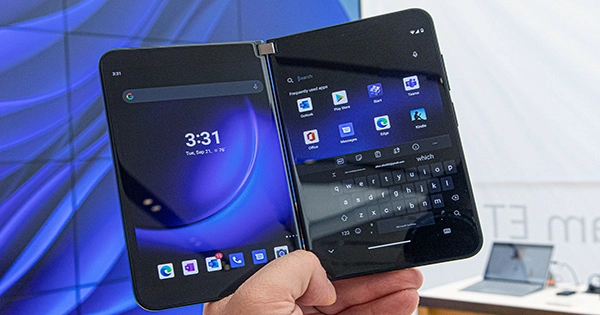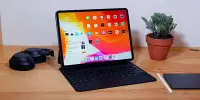Microsoft might have finished developing the current Surface Duo series. The firm has been the only significant OEM to commit to the dual-screen form factor, but the most recent rumor suggests that the firm plans to change things up with its upcoming Surface Duo model.
Windows Central claims that Microsoft is foregoing the dual-screen design in favor of a tablet with a foldable screen. Their source claims that the company wants to create a phone with an internal folding display and an external cover screen that resembles some of the best foldable phones now available. It appears that the dual-screen Surface Duo 3 will be replaced by this new foldable phone, which is expected to go on sale at the end of 2023.
Fans of the Surface Duo who prefer having two independent displays over a single folding panel may be disappointed by this revelation, of course. In contrast to the still-fragile folding displays used in devices like the Galaxy Z Fold 4, the former is probably a more robust solution. Even though I never used the product extensively, I appreciated Microsoft’s efforts to maintain support for the oddly neglected form factor.
As an alternative to the large-screened foldable, I mentioned in last year’s article that I would want to see more dual-screen phones available. With successive device launches, LG tried to make this form factor more common, but only Microsoft appeared to be truly devoted to it. But with the recent reports that Microsoft may be dropping dual screens, it appears that the form factor is all but extinct—at least for smartphones.
Dual-screen phones, according to Moor Insights & Strategy’s lead analyst Anshel Sag, never truly established their foothold in a world where foldable are taking center stage. “I believe that two screens never really caught on since, aside from Microsoft’s design, they were relatively bulky and weren’t as svelte as many foldable, and the software was geared for foldable, not dual-screen devices,” said the author.
Although it may not be the preferred course for Microsoft or its supporters, the decision to switch to a foldable display is a necessary one, as it may make components easier to the source by no longer relying on custom parts, according to Windows Central’s Daniel Rubino, who explained why he prefers the Surface Duo 2 over the Galaxy Z Fold 4. Microsoft already faces a formidable uphill struggle to persuade customers to purchase their phones, according to Rubino. “A single-screen foldable is definitely where the rest of the market is heading,” he adds. “That strain will be lessened by this design modification, which also makes this Surface phone more “normal”.
The article also mentions that Microsoft is considering various form factors, such as a slab smartphone that is more conventional, which might help its hardware initiatives. On its plans for upcoming Surface Duo models, Microsoft was unable to comment.
According to Rubino, the community for the Surface Duo is rather modest in comparison to the rising number of people who are purchasing Samsung’s foldable phones. This is partial because Samsung’s emphasis is more on entertainment, which benefits from the huge, single display, whereas the Surface Duo is more of a productivity tablet. The lack of a significant marketing effort by Microsoft, which ostensibly allowed its vastly enhanced Surface Duo 2 to sit on store shelves until it runs out of stock, has contributed to the device’s underwhelming reception.
According to Rubino, the community for the Surface Duo is rather modest in comparison to the rising number of people who are purchasing Samsung’s foldable phones. This is partially because Samsung’s emphasis is more on entertainment, which benefits from the huge, single display, whereas the Surface Duo is more of a productivity tablet. The lack of a significant marketing effort by Microsoft, which ostensibly allowed its vastly enhanced Surface Duo 2 to sit on store shelves until it runs out of stock, has contributed to the device’s underwhelming reception.
However, the thought of there no longer being a practical dual-screen option has me feeling let down. In no way is the Surface Duo 2 a subpar phone. It has two gorgeous OLED panels, an improved triple camera system, a useful stylus pen, and excellent software. But despite the Duo 2’s use of a now-outdated Snapdragon 888 CPU, it always appeared like Microsoft was lagging behind with each new version of the Duo.
Fortunately, the Surface Duo 2 seems to rely heavily on its excellent software, which might also be the case for the Surface foldable, whatever that device might be called. According to Windows Central, “a broader software project occurring inside” attempts to set Microsoft’s foldable apart from the competitors. This isn’t exactly what it is, but it might combine Microsoft’s work tools with a stronger emphasis on media and leisure. This initiative apparently called “Perfect Together” (not to be confused with Google’s “Better Together”), may also bolster the expanding ties between Windows PCs and Android phones, something we’re starting to see more of recently with gadgets like the Lenovo ThinkPhone by Motorola.
Fans of the Surface Duo are hopeful that Microsoft will take the route of implementing a virtual dual-screen experience, according to Rubino. “On Fold 4, users can choose to divide the screen in half to display two neighboring apps instead of the typical single screen/single app experience. Instead, Microsoft could make running two apps simultaneously the default experience, requiring users to drag one of the apps to the middle in order to “span” it.” Users of existing Duo models effectively get this experience, but the screen separation would only be software-based.
Microsoft, according to Sag, has the potential to stand out in a way that Samsung hasn’t really exploited. “It would undoubtedly have to come from Microsoft’s AI skills and closer interaction with its current products, such as Office 365 and Xbox xCloud. With the Fold series, Samsung has already incorporated many Microsoft strengths; therefore, the best ways to stand apart will need to be in areas where Samsung hasn’t, such as AI.” Microsoft could surely use this with the rumored plans to incorporate ChatGPT into Bing.
With regard to the user interface, the Android 12L upgrade, which added features like enhanced multitasking and a taskbar, already brought about a lot of changes on the foldable front. The upgrade for the Surface Duo added new pen capability as well as a more Windows-like user interface. Microsoft may need to put more emphasis on these upgrades while balancing the delicate task of maintaining the beloved features of the Surface Duo with the need to design a product that will appeal to a wider audience.















